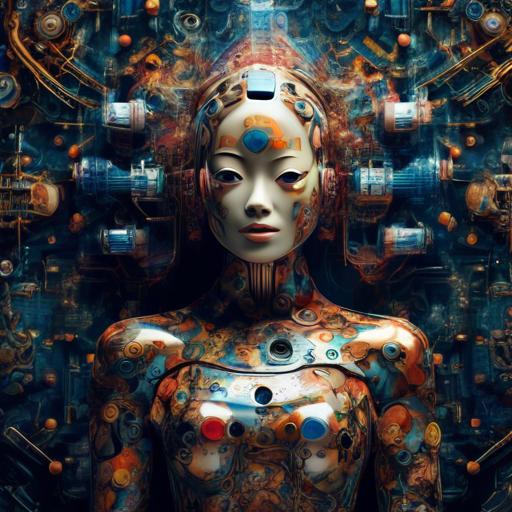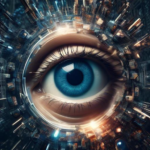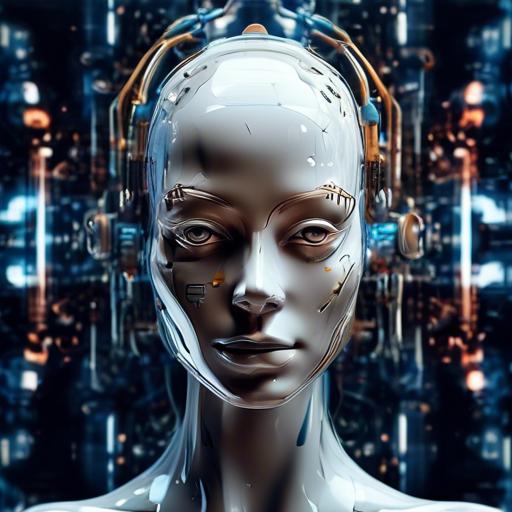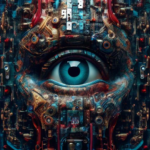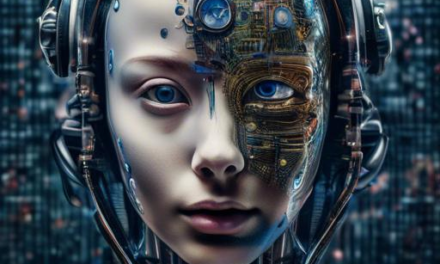In the ever-evolving tapestry of human creativity, a new thread is being woven—one that shimmers with the promise of artificial intelligence. Picture a seasoned painter, her brush poised, conjuring visions from her imagination. Now, imagine a sleek algorithm standing beside her, silently suggesting hues, enhancing details, and challenging boundaries. This synergy, once the stuff of science fiction, is now vibrant reality. The world of traditional art forms, rich in history and emotion, is beginning to dance to the rhythm of AI’s intricate algorithms. But rather than casting a shadow over the canvas, AI illuminates new pathways, infusing age-old practices with boundless possibilities. Welcome to a dialogue between the timeless and the futuristic, where art not only persists but thrives in the company of its most innovative collaborator yet.
Table of Contents
- Embracing Algorithms: AI as a New Artistic Tool
- The Symphony of Silicon: AI in Music Composition
- Brushstrokes by Bytes: AI in Visual Arts Creation
- Script to Screen: How AI is Transforming Filmmaking
- Beyond the Canvas: AI’s Role in Sculpture and Installation Art
- The Creative Partnership: Artists and AI Collaborations
- Preserving Tradition: Balancing Innovation with Heritage
- Harnessing AI: Practical Tips for Artists
- Navigating the Ethical Landscape in AI Art
- Wrapping Up
Embracing Algorithms: AI as a New Artistic Tool
Dive into the world of **algorithms and creativity**, where artificial intelligence (AI) emerges as a **powerful tool for artists**. This fusion allows for the creation of art pieces that were once deemed impossible or extremely time-consuming. AI can analyze patterns, styles, and colors, offering a new palette for artists to experiment with and expand their creative horizons.
**Key benefits of AI in art** include:
* **Precision**: AI can generate highly detailed images, enhancing the quality and intricacy of artworks.
* **Speed**: Traditional techniques that took weeks can be accomplished in mere hours.
* **Innovation**: AI introduces new methods and styles, pushing the boundaries of conventional art forms.
Consider the way AI has revolutionized **digital sculptures and 3D modeling**. Artists can now simulate realistic textures and forms with unmatched accuracy. Sculpture creation, which was once a lengthy and complex process, is now streamlined, allowing for more spontaneous and experimental designs.
| Art Form | AI Enhancement |
|---|---|
| Painting | Style Transfer |
| Music | Composition Algorithms |
| Sculpture | 3D Modeling |
**Traditional mediums such as painting** have also found a complementary partner in AI. Imagine an AI that can analyze an artist’s unique brush strokes and create an entirely new piece in their signature style. This not only preserves artistic legacy but also introduces new dimensions to the exploration of technique and form.
Moreover, AI can serve as a **collaborator** rather than a mere tool. Imagine a digital assistant capable of offering suggestions or variations when an artist hits a creative block. This symbiosis enhances the artistic journey, blending the realms of human ingenuity and machine precision for a future where art can continually evolve and inspire.
The Symphony of Silicon: AI in Music Composition
Imagine a world where machines and melodies intertwine, where algorithms compose symphonies and neural networks hum harmonies. **Artificial Intelligence (AI)** has begun to tiptoe into the realm of music composition, pushing the boundaries of creativity and transforming the traditional art form in astonishing ways.
AI doesn’t just replicate human creativity—it enhances it. Using **machine learning** algorithms, AI systems can analyze vast libraries of music, identifying patterns and trends invisible to the human ear. This allows composers to **generate new and innovative musical pieces** that would be virtually impossible to create manually. Here are some ways AI is reshaping music composition:
- Creating original compositions by learning from existing musical styles
- Providing real-time suggestions for chord progressions and harmonies
- Offering tools for mixing and mastering tracks with unparalleled precision
Music composed by AI has found its way into video games, films, and even live performance. By examining musical trends across genres and eras, AI can compose pieces that evoke specific emotions or fit particular themes—whether it’s the haunting strains of a thriller soundtrack or the upbeat rhythms of a pop anthem. Here’s a brief look at some applications:
| Application | Description |
|---|---|
| Film Scoring | AI generates contextual scores matching the narrative. |
| Video Game | Dynamic soundtracks that adapt to player actions. |
| Live Performance | Interactive compositions that change in real-time. |
While some may fear that AI will replace human composers, it’s more accurate to see it as a tool that augments human talent. **Collaborative AI systems** open up new avenues for composers to experiment and innovate, allowing for a symbiotic relationship where both man and machine learn and grow from each other.
The fusion between silicon and symphony is more than just a novelty; it’s a vibrant testament to the boundless possibilities of technology enhancing our artistic endeavors. As we move forward, AI promises to continue its harmonious collaboration with musicians, crafting a future where creativity knows no limits.
Brushstrokes by Bytes: AI in Visual Arts Creation
In recent years, artificial intelligence has increasingly found its way into the realm of visual arts, offering both new opportunities and challenges for traditional art forms. The blending of AI with artistic creativity has given rise to a unique synergy where *algorithms meet aesthetics*. AI is not just a tool but an **innovative collaborator** that redefines the boundaries of what we consider art.
A growing number of artists are harnessing the power of AI to **augment their creative processes**. From generating initial sketches to adding intricate details, AI-driven software can perform tasks that might take humans hours, if not days, to complete. Here are some of the ways AI is transforming traditional art:
- Dynamic Color Schemes: AI algorithms can analyze thousands of artworks to suggest dynamic, harmonious color palettes, helping artists to experiment with novel hues that they might not have considered.
- Pattern Recognition: Machine learning models can study an artist’s style and generate new pieces that closely mimic their unique touch, enabling the creation of series or replicas.
- Complex Animations: AI can turn static designs into animated sequences, bringing a new dimension of engagement to traditional art.
- Effortless Scaling: AI tools allow for easy scaling of artworks without losing detail or quality, making it easier for artists to apply their creations across different media.
However, the blend of AI with traditional art is not without its controversies. Purists argue that the essence of art lies in human emotion and experience, something that machines inherently lack. Nevertheless, many artists view AI as a source of *inspiration and efficiency*, enabling them to focus more on the conceptual aspects of their work while leaving the repetitive tasks to machines.
| Aspect | Traditional Art | AI in Art |
|---|---|---|
| Time Investment | High | Optimized |
| Creative Process | Manual | Assisted |
| Replication | Laborious | Effortless |
| Possibilities | Limited | Infinite |
AI’s role in the visual arts is multifaceted, providing a bridge between the traditional and the modern. While it brings an abundance of new possibilities, it also challenges us to rethink what constitutes authentic artistic expression. The future of art, it seems, lies in a *harmonious coexistence* where human creativity and AI innovation come together to create increasingly sophisticated and impactful works.
Script to Screen: How AI is Transforming Filmmaking
In the past few years, artificial intelligence has stepped into the glamorous world of cinema, revolutionizing every step from pre-production to post. The influence is undeniable, as AI-powered tools and technologies become increasingly capable of assisting filmmakers in creating breathtaking visuals and compelling narratives.
**AI has significantly impacted scriptwriting**. Algorithms now assist writers by generating dialogues, plot ideas, and even complete screenplays. This innovation helps overcome writer’s block and enables creative minds to experiment with unprecedented storylines and genres. For instance, OpenAI’s GPT-3 model has shown remarkable potential in crafting coherent scripts that can serve as a valuable starting point for screenwriters.
- Enhanced Visual Effects: AI can streamline the process of creating stunning visual effects, reducing both time and cost. Sophisticated algorithms can now generate realistic environments and characters, blending seamlessly with live-action footage.
- Efficient Editing: Advanced video editing software such as Adobe Premiere Pro and Davinci Resolve utilize AI to offer tools like automatic scene detection, color grading, and seamless transitions.
- Personalized Viewing Experience: AI helps tailor content based on viewers’ preferences, predicting what they might enjoy watching next and curating customized playlists.
One of the groundbreaking advancements is in the realm of casting. AI-powered casting directors can analyze hundreds of audition tapes in a fraction of the time it would take a human. They can match actors’ performances with the desired characteristics of the characters, ensuring a perfect fit for each role. This efficiency not only saves time but also brings to light talents that might have been overlooked in traditional casting processes.
| AI Applications | Benefits |
|---|---|
| Script Generation | Saves time and sparks creativity |
| Visual Effects | Reduces costs, enhances quality |
| Audio Enhancement | Improves sound quality, automates mixing |
| Personalized Content | Increases viewer engagement |
With all these advancements, filmmakers are not just embracing AI; they are collaborating with it, turning futuristic ideas into reality. The marriage of traditional storytelling and cutting-edge technology is crafting a new era of cinematic experiences, one where boundless imagination meets unparalleled technological prowess.
Beyond the Canvas: AI’s Role in Sculpture and Installation Art
Artificial Intelligence is disrupting traditional art forms, redefining boundaries, and opening new frontiers in sculptural and installation art. Far from negating the inherent human touch, AI enhances creativity, allowing artists to execute their visions with remarkable precision and innovation.
- Dynamic Interactivity: AI-infused installations react dynamically with their environment, creating experiences unique to each viewer.
- Advanced Materials: AI can optimize material usage, contributing to more sustainable and eco-friendly sculptures.
- Imaginative Possibilities: With AI’s assistance, artists can transcend traditional forms, venturing into abstract and futuristic designs that would be impossible to create manually.
Consider the intricate kinetic sculptures, where AI algorithms drive complex motions. These artworks evoke a sense of life, structure, and calculation, providing an unparalleled immersion. Neural networks analyze human movement, environmental changes, and other parameters to trigger responses, making art an ever-evolving tapestry of interaction.
| AI Technology | Application in Art |
|---|---|
| Machine Learning | Creating adaptive and responsive art installations |
| 3D Printing | Crafting detailed and complex sculptures |
| Computer Vision | Analyzing and integrating real-time visual feedback |
Moreover, AI democratizes art-making processes. Complex software tools are now accessible to a broader audience, allowing emerging artists to experiment and reach their full potential. This leveling of the playing field fosters a vibrant community where innovation thrives.
The collaboration between AI and human creativity symbolizes a future where art continuously evolves, reflecting the intricate dance between nature, technology, and imagination. Herein lies the crux of modern sculptural and installation art – a blend of timeless tradition and cutting-edge intelligence.
The Creative Partnership: Artists and AI Collaborations
The union of artists and Artificial Intelligence (AI) has sparked a revolutionary wave in the traditional art scene. This innovative fusion brings forth new methodologies, enabling artists to explore realms previously unimaginable. By incorporating AI, traditional art forms are being transformed, adding layers of depth and complexity that captivate audiences in unprecedented ways.
- Limitless Creativity: AI tools provide artists with instant access to a vast array of styles and techniques. This allows for a more dynamic and eclectic approach to their work, blending classic and contemporary elements seamlessly.
- Enhanced Precision: Precision is another significant advantage offered by AI. Artists can use algorithms to perfect their techniques, creating intricate details that are both awe-inspiring and technically flawless.
- Accessible Innovation: AI democratizes artistic innovation. Emerging artists, regardless of their traditional training, can experiment with AI-driven tools to craft unique pieces that reflect their personal vision.
| Traditional Art Form | AI Enhancement |
|---|---|
| Painting | Style Transfer Algorithms |
| Sculpture | 3D Modeling Software |
| Music | AI Composition Tools |
As artists continue to embrace AI, they’re discovering novel ways to elevate their craft. For instance, painters can employ neural networks to merge their natural brushwork with unique digital elements, creating hybrid artworks that stand out in the modern art world. Similarly, sculptors can use AI to design and test their concepts in a virtual space before bringing them to life in a physical form.
Musicians are not left out of this revolution. AI-driven composition tools are enabling composers to experiment with new sounds and harmonies, pushing the boundaries of music to create innovative and emotionally resonant pieces. This synergy ensures that traditional art forms remain vibrant and relevant in an increasingly digital age.
Preserving Tradition: Balancing Innovation with Heritage
Artificial Intelligence (AI) and its burgeoning advancements provide both opportunities and challenges for preserving and elevating traditional art forms. The fear that technology may overshadow heritage is real, but **embracing AI** offers a harmonious blend of the old and new, enabling traditions to flourish in ways previously unimaginable.
One of the significant ways AI supports traditional art is through **enhanced preservation**. Technologies such as **machine learning algorithms** and **image recognition** help catalog and maintain detailed records of historical artifacts, ensuring they are accessible for future generations. AI can also assist in restoring aged pieces with precision, offering new life to relics without compromising their authenticity.
Additionally, AI empowers artists by providing new tools and methods to create art that **honors tradition** while introducing **innovative techniques**. For example, a dance choreographer can use AI to analyze classical dance forms and generate new choreography that maintains the essence of traditional movements. Similarly, musicians can employ AI-driven software to compose pieces that fuse age-old styles with modern arrangements.
Benefits of AI in Traditional Art:
- Enhanced Preservation
- Precision Restoration
- Innovative Creation Methods
- Global Accessibility and Outreach
| Aspect | Traditional Method | AI-Enhanced Method |
|---|---|---|
| Preservation | Manual Cataloging | AI-driven Archiving |
| Restoration | Hand Restoration | Machine Learning Restoration |
| Creation | Classical Techniques | Algorithmic Assistance |
Nevertheless, it’s essential to engage stakeholders from the **traditional art community** in these technological endeavors. Respecting the cultural context and the symbolism ingrained in each art form ensures that the evolution fueled by AI is both meaningful and respectful. This collaborative approach guarantees that **heritage art forms** not only survive but thrive in the digital age.
Harnessing AI: Practical Tips for Artists
Integrating artificial intelligence into the artistic process offers a myriad of opportunities for enhancing creativity while maintaining the essence of traditional art forms. AI can be a supportive tool rather than a replacement, offering artists new perspectives and techniques to enrich their works.
Exploring AI-Generated Inspirations:
- Utilize AI algorithms to generate unique patterns, color schemes, and compositions that can serve as a tool for brainstorming.
- Experiment with platforms like DeepArt or ArtBreeder, which allow artists to create new pieces based on existing ones, blending different art styles seamlessly.
- Create a repository of AI-generated designs that can be used as references or starting points for traditional artworks.
Refining Traditional Techniques with AI:
- Employ AI tools for meticulous tasks such as outlining, shading, or adding texture, thus saving time for more creative endeavors.
- Use AI-assisted software to simulate different artistic techniques, helping you choose the best approach before committing to a particular style.
- Embrace AI-driven corrections for proportions and perspective, ensuring that foundational elements are polished and precise.
Collaborative AI-Art Projects:
- Participate in AI-art collaborations where human artists and machines co-create stunning pieces, merging traditional skills with high-tech innovation.
- Explore interactive installations that incorporate AI, allowing audience participation to influence the final artwork dynamically.
- Work with developers to create custom AI models tailored to your unique artistic style, enhancing personal expression with cutting-edge technology.
Key AI Tools and Platforms for Artists:
| Tool | Function |
|---|---|
| DeepArt | Transforms photos into artwork using neural networks. |
| ArtBreeder | Creates new images by blending existing ones, facilitating exploration of creative variations. |
| Runway ML | Provides easy-to-use AI tools for artists and designers, enabling innovation in media creation. |
Navigating the Ethical Landscape in AI Art
As artificial intelligence weaves its intricate threads into the fabric of traditional art forms, the ethical tapestry becomes ever more complex. **AI art** raises questions about authorship, originality, and cultural impact. It’s essential to explore these questions not just to guide artists today, but to preserve the integrity and diversity of art for future generations.
- Authorship and Ownership: Who owns the art created by AI? The programmer, the machine, or the entity commissioning the piece?
- Originality: Can AI-generated art be considered original if it’s built upon existing data sets provided by human artists?
- Cultural Impact: How does AI art influence cultural representation and authenticity?
Beyond the murky waters of legal ownership, there’s a more intrinsic question: What does it mean to be an artist in the age of AI? Traditional artists pour their soul into each brushstroke or pixel, but an AI algorithm lacks the human experience and emotional depth. How, then, can AI-generated pieces reflect the complexities of human emotion and experience?
| Aspect | Traditional Art | AI Art |
|---|---|---|
| Creation | Human Experience | Algorithmic Process |
| Authorship | Single Artist | Machine and Programmer |
| Originality | Deeply Personal | Data-Driven |
It’s also worth considering the **inclusive nature** of AI tools. While AI can democratize art creation, making it accessible to those who may lack traditional skills, it can equally risk homogenizing artistic expression. The balance between inclusivity and preserving diverse, authentic voices is delicate but crucial.
the journey through the ethical landscape of AI art is not one to shy away from but to approach with **intention and awareness**. By navigating this evolving terrain thoughtfully, we can harness the strengths of AI while upholding the values that make art a uniquely human endeavor.
Wrapping Up
the rise of AI in traditional art forms is not to be feared, but rather embraced as a powerful tool for creativity and innovation. It has the potential to enhance our artistic endeavors and challenge us to think outside the box. As we navigate this new era of technology and art, let us remember that the essence of creativity lies within us, and AI is simply a means to expand our imaginations. Let us continue to push boundaries, experiment fearlessly, and create art that is truly groundbreaking. The possibilities are endless, and the future is bright for the intersection of AI and traditional art forms. So let us dive in, with curiosity and excitement, and see where this beautiful journey will take us.

